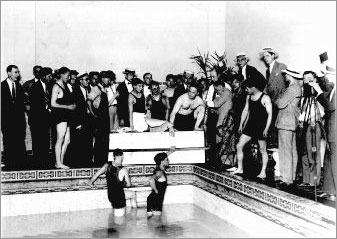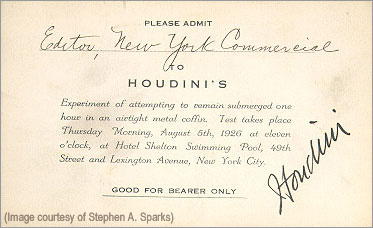
|
| |
1910–1924 | 1925–1926 | 1927–1930 | 1931–1943 | MORE RECENT
HOUDINI WINS TEST IN A SEALED CASKET Stays Under Water in Airtight Case an Hour and a Half With No Ill Effects. BEATS HINDOO’S RECORD Had Telephone Connection With the Outside World—Anybody Can Do It, He Insists.  Harry Houdini gave a demonstration yesterday of remaining for an hour and a half sealed in an airtight metal casket at the bottom of the swimming pool at the Hotel Shelton, Forty-ninth Street and Lexington Avenue, without any visible means of obtaining air. Harry Houdini gave a demonstration yesterday of remaining for an hour and a half sealed in an airtight metal casket at the bottom of the swimming pool at the Hotel Shelton, Forty-ninth Street and Lexington Avenue, without any visible means of obtaining air.
He was lowered into the pool at 12:09 P.M., and exactly 1 hour, 31 minutes and 31 seconds later the casket was lifted to the surface. Two minutes later a brass plate was unscrewed. Houdini thrust his arm through the aperture so that Dr. W.J. McConnell of the Philadelphia Health Council could examine his pulse. The doctor reported it to be 142. Before going down it was 84. Meantime, four tinsmiths were ripping open the six-and-a-half-foot galvanized casket. When Houdini finally stepped forth he looked pale and fagged and seemed barely able to speak. He was then further examined by Dr. McConnell as to his respiration, temperature and blood pressure. The doctor reported that physical reactions were not marked. No Trickery, He Says. Houdini, who is an opponent of spiritualism, had announced he would make the experiment to prove that any man could stay sealed up under water for a long period without being possessed of “supernatural powers.” It was a scientific test, without trickery or collusion, he said. His record yesterday eclipsed by half an hour that made by Rahman Bey, Hindu who recently remained sealed in a zinc casket for one hour at the Dalton Swimming School in West Fifty-ninth Street after going into what he called a “trance.” During his stay under water in the coffin, which was soldered after the top was screwed on, Houdini kept in communication with James Collins, his personal representative, over a telephone connection, by which he indicated every few minutes by pushing a button that rang a bell that he was all right. It was computed that there were 34,398 cubic inches of air in the metal case. The oxygen in that air, according to physicians, should have been entirely used up in three or four minutes. Some said that Houdini breathed “close” air, filled with carbon dioxide. There were several doubting Thomases among the hundred spectators who insisted that oxygen was supplied by the electric batteries in the casket or through the telephone wire. Before he stepped into the casket, clad in a white shirt and bathing trunks, Houdini said he did not contend that the coffin was “airless,” but that it was airtight. He wore a wrist watch with a radium dial. Mr. Collins announced the time to him every five minutes, however, during the first half hour, and every minute during the remainder of the test. Casket Bobs Around. Six workmen in bathing suits sat on the casket to keep it down, which the 1,000-pound iron weights at each end refused to do. Things went along smoothly for the first half hour. Then in shifting his position one workman fell off the casket. The others lost their balance, slid into the water and up bobbed the casket. It kept bouncing around like a rubber ball, once turning half over. It settled back into position when the six workmen jumped aboard again. To save his breath Houdini had refrained from some time from talking. But he talked now. “What’s the big idea? What struck me?” he asked. Collins soothed him. The test continued without disturbance until an hour had elapsed, when the bell rang. Houdini then wasted some more oxygen.
When the hour and a half was up he gave the signal to haul him up. “Any one can do it,” he said later. “The important thing is to believe that you are safe, don’t breathe too deeply, and don’t make any unnecessary movements.” He expressed the opinion that fear and not poisoning by carbon dioxide caused the death of miners and others trapped in airtight compartments. Dr. McConnell reported Houdini’s respiration before going down as 20, and on coming up, 17; his temperature before, 98.6; afterward, 99; his systolic blood pressure before, 141; afterward, 162; his diastolic blood pressure before, 84; afterward, 42. This article is reproduced here only for educational purposes. Please do not copy the text or accompanying images for commercial use.
|
 “The coffin is leaking,” he said.
“The coffin is leaking,” he said.